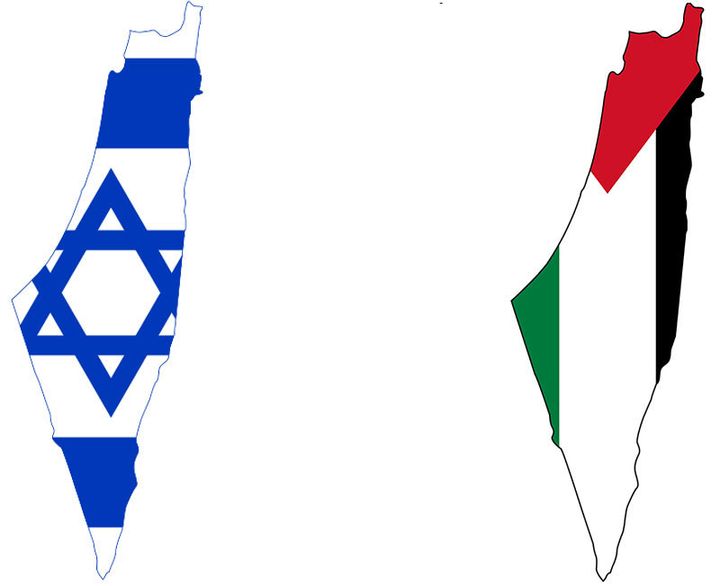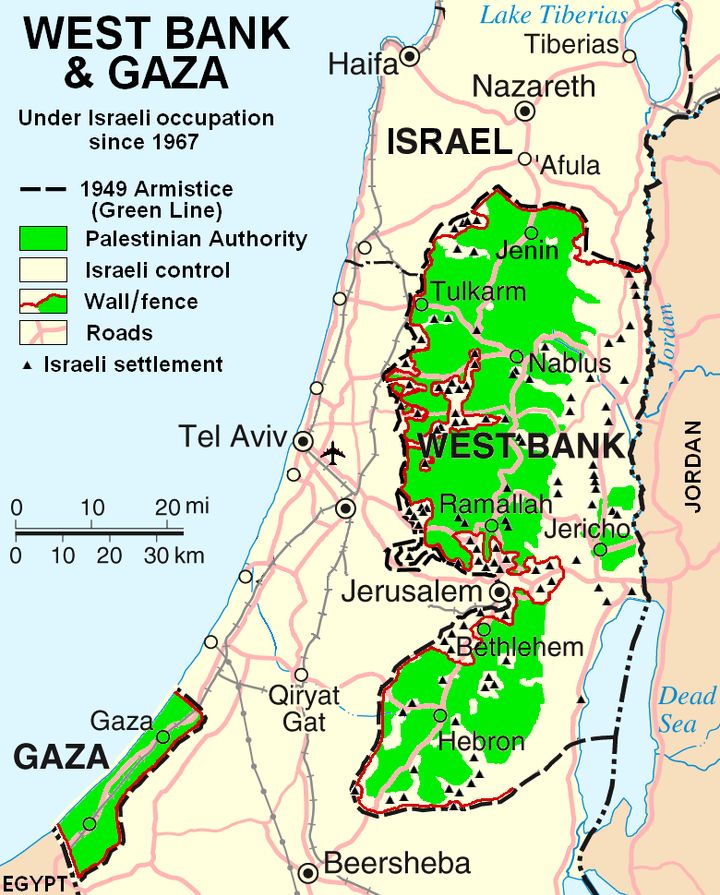
A hypothetical rendering of the flag that might one day represent the Israel-Palestine confederation, in addition to the distinct national symbols for each of the states.
Proposed framework of ‘two states, one homeland’ reflects interdependent reality
One of the most complex conflicts on earth, a Gordian Knot in the fraught Middle East, remains unsolved after a century of never-ending partition plans.
None of the various final-status maps proposed to end the cyclical Israeli-Palestinian crisis has actually come to fruition, and the facts on the ground at the edges of today’s status quo remain largely based on unilateral settlement by the occupying power beyond faded ceasefire lines.
Yet with the recent election of Donald Trump as American president, there is said to be fresh hope that the consummate businessman could employ new ideas as part of the “ultimate deal.”
Several ambitious proposals for peace based on the “parallel states” concept throw conventional wisdom into the Mediterranean, choosing instead the bold idea that the geographic entirety of the Land of Israel and Historic Palestine in fact belongs to both at the same time.
How is that possible? Two-in-one overlapping river-to-the-sea entities are mutually recognized as superimposed upon each other. The two nations and peoples maintain separate identities and narratives, but sovereignty over the land is administered jointly on many levels. There are different labels for the overall super-structure (confederation or union), but more important than the name are robust bilateral relations, flexible movement, increasingly open borders, and a nuanced citizenship paradigm.
Beneath the all-pervasive cynicism of this epoch is an increasingly common trend towards a solution that transcends the binary notion of having either “one” or “two” states. Electing such a peace recipe combines pragmatic methods with constructive dialogue, which has the potential to trump ideology.
This new genre of peace plan, while admittedly being far from the present state of affairs, incorporates all aspects of the interconnected, intimate, and antagonistic relationship between Israel and Palestine. Its logic flows from the reality that the two already share economic space (currency, customs, taxes, and jobs) and split military control (Israeli domination, limited local rule by the Palestinian Authority in the West Bank, and Hamas in Gaza).

Full outline of Land of Israel / Historic Palestine, illustrating imagined, fictitious control over the whole territory.
‘One’ and ‘two’ at the same time
Born a decade ago out of the ashes of the Second Intifada, the core of the “parallel” strategy -- and the related “two states in one space” and “two states, one homeland” proposals that emerged a few years later -- is that a fixed and impregnable Israeli-Palestinian border is impossible, given messy land use and transportation networks.
Since the end versions of two-state and one-state “solutions” -- and everything on the continuum in between -- bear little resemblance to the geopolitical stalemate of 2016, why not address the fundamental issues in a fresh and incisive way?
Mathias Mossberg, one of the “parallel states” co-editors, along with Mark LeVine, of the 2014 book “One Land, Two States,” says of the modest but futuristic vision: “We do not intend to present a ready-made model...the concept of two separate states with parallel sovereignty over the same territory is obviously nothing that can be achieved overnight.”
While the historical models cited by Mossberg, a fellow at the Center for Middle Eastern Studies at Lund University in Sweden, include the unique Swiss cantons and the Andorran diarchy, the polite rules of Western Europe don’t quite hold sway in the Levant. That being said, a political “condominium” could be feasible if mechanisms for cooperation are strong.
There would be still be separate Israeli and Palestinian government institutions and security forces, in addition to a “supreme” set of new, collaborative bodies across which a range of third-party supervision would need to ensure fair decision-making. Yet naturally, the challenges are immense for determining who can live where and how barriers to movement are lifted.
The plan appears to make accommodations for the most existential of concerns on both sides: Israeli security needs on the one hand, and on the other, Palestinian desires for return, including by refugees, to some of the territory. Obviously both would be tempered by reasonable limits to authority and communal resources, which both depend upon endless compromises.
Still, putting the principles into practice would be a long, hard struggle. When the “two states, one homeland” project launched last year, moderates on both sides were prevented from attending as a result of the stigma associated with coexistence initiatives -- with anti-normalization and BDS activists protesting on the Palestinian side, and political scaremongering a roadblock for many Israelis. Real progress with the concept -- as with any other plan -- would require direct negotiations between diplomatic officials at the highest levels.
To forge “one homeland,” the proposal declares that “citizens of both states have the right to travel and live in all parts of the land...toward full realization of this vision in several stages, mutually, and each step will require the agreement of both states.”
Awni Al-Mashni, a major Palestinian proponent of the idea, wrote last year: “Israeli citizens residing in Palestine and Palestinian citizens residing in Israel will be subject to the law of the state in which they live and enjoy [that state's] civil rights, but will be able to exercise their political rights [only] in the state of which they are citizens.”
“Jerusalem would be one city, shared and open to the citizens of both states,” the plan explains. “A special municipal regime would be established to administer the city jointly and equally between the two peoples, together with representatives of the monotheistic religions and the international community.”
Hilik Bar, deputy speaker of the Knesset and an outspoken center-left Israeli proponent of the traditional two-state solution, argues that the standard formula preferred by the international community -- despite being on the rocks for well over a decade -- is still optimal.
“I don’t believe in the idea of ‘parallel states’,” Bar said. “It will not work for the long term. I am a strong believer in the separation for two states for two people...it’s the only possible solution for us and the Palestinians.”
Emphasizing that around one-fifth of Israel’s population is Arab, he also suggested that “the future Palestinian state should host some of the settlers of today as citizens or residents,” a notion shared with the “parallel states” plan.

Map from 2007 illustrating the limited autonomy of Palestinian areas in the West Bank and Gaza Strip.
‘Together and separate’
Israel and Palestine are probably too enmeshed to achieve full separation. However, they are much more divided than in the late 1990’s, when Israelis shopped at West Bank markets, and Palestinians enjoyed walking along the seafront promenade in Tel Aviv -- well before the massive security barrier was erected. Yet now, untold thousands sneak across the fence-wall every day, so its present separation function is questionable.
In any event, the two “national heartlands” would largely be preserved, so as to minimize confusion and reduce the number of geographic areas that would require joint supervision. Israeli-born Arabs who identify more strongly with Palestinian identity would be able (with families and/or villages) to assume that political affiliation, vote in Palestinian elections, and participate fully in the national discourse. Citizenship would follow ethnicity, not territorial lines.
Law enforcement officials would obviously have to agree on when legal cases would be heard by the national or local courts, and when a matter would require adjudication by a higher institution that could deal with the most sensitive human rights cases.
Moreover, the physical assets of the land would also be supervised together: “Roads, railways, water, and energy infrastructure can be shared,” asserts the broad outline of “Two States in One Space,” formulated by the nongovernmental organization IPCRI (Israel-Palestine: Creative Regional Initiatives).
Israeli President Reuven Rivlin has often cited the possibility of an Israeli-Palestinian confederation as ideal, and in an interview last month he again reiterated this hope. While the Israeli head of state holds no executive power, which is all vested in the prime minister, his symbolic support for such an arrangement could add weight to those calling for such a plan to be put into practice. Regardless a final plan would go to the Knesset for ratification.
Despite Rivlin’s consistent and outspoken support for Arab human rights and stronger Palestinian civil authority, detractors point to the fact that he has generally couched such statements in the language of Israeli sovereignty. In addition, implicit in such politics is the right for Jews to settle the entirety of the territory, but perhaps not equivalent provisions permitting Palestinians from the West Bank or Gaza to move to Jaffa or Haifa.
Indeed some Palestinians are suspicious that many of the Israeli advocates for parallel states are settlers. But one iteration of the plan would let the same percentage of Jews live within the Palestinian-controlled areas as the percentage of Arabs who could live within the Jewish-designated heartland.
This arrangement is different from a unitary or binational state because it would allow for the self-determination of both peoples. And it fulfills the intangible need for mutual recognition. A “parallel states” confederation would seem to address the biggest grievances with the purely one-state solution: neither Zionism nor Palestinian nationalism is prepared to give up long-held dreams for independent states.
According to Rivlin’s spokesman, Jason Pearlman, the president believes that peace “is not a zero-sum game.” His favorite refrain: “The Jews and the Arabs of this land are not doomed to live together, they’re destined to live together.”

Movement leaders say the effort is a more practical and popular version of “parallel states.”
‘Part of a larger union’
Meron Rapoport, a prominent Israeli journalist, and Muhammad Beiruti, a ranking member of Fatah, are among the founders of the “two states, one homeland” idea for an EU-like body politic.
Rapoport eagerly articulated how his group’s plan diverges from the “parallel states” concept: “While sharing the basic conclusion that the land between the Jordan River and the sea is one land, and that clear-cut separation is nearly impossible, and certainly undesirable, I think that the ‘parallel states’ idea is vague, profoundly impractical, and tends to maintain the Jewish dominance over the land.”
“Palestine and Israel will be part of a larger union,” he believes. But he also points out one of the biggest problems with the confederation scheme, and other plans that draw on the classic one-state vision: “It is quite evident that if the boundaries of Palestinian sovereignty would not be clear, then Israel will maintain its superiority in all fields of life.”
In addition, Rapoport said that his “practical utopia” project is buttressed by a “political organization with hundreds of followers and constant activity, while ‘parallel states’ is a pure intellectual exercise.” He views the “two states, one homeland” plan as a more tangible incarnation of “parallel states” with broad, grassroots backing. But he also acknowledges that the group’s peace brand has not yet become a household name, largely because of financial constraints.
Where Rapoport has little hope that the Israeli hegemon will cede any control unless truly compelled, Beiruti actually praises where he sees flexibility in the “parallel states” setup.
“Palestinians and Jewish people completely have the same belonging to the whole area, and at the same time, are mixed in it,” Beiruti said. “Palestine is not capable [of being] divided.”
“We accept the reality that Israel exists, and we have to...find a way in it [so] we Jews and Arabs can live together,” he added. Yet, Beiruti concluded, “Ending the occupation is the main [issue].”
One must hope that the eventual solution will address the core grievances on both sides: for Israel, security shortcomings and widespread rejection of the Jewish state’s right to exist; and for Palestinians, military occupation and constant displacement.
So how does the “one homeland” vision contend with the specter of permanent terror? Rockets from Gaza, random shooting attacks, and settler-inflicted violence, for example, would still require extraordinary vigilance.
Perhaps the trickiest long-term part of any plan is how to compensate those who lost their homes on both sides and how to temper competing rights of return. And with the current intra-Palestinian split, along with unprecedented regional chaos and a risk-averse Israeli government, big leaps towards peace are probably not on the horizon.
The tidy “parallel states” abstraction could only ever materialize as a dazzlingly jumbled and imperfect integration of Israel and Palestine. But marketing the blueprint with require much simplicity and political clout.
“Parallel states is just about the only way a ‘two-state’ solution could now be implemented, given the present physical and political obstacles to [full] territorial division,” Mossberg concludes, arguing that the plan, while certainly not a silver bullet, would “keep Israel demographically Jewish and Palestine demographically Palestinian.”
